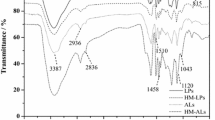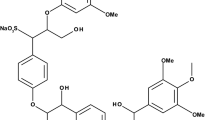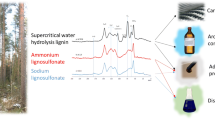Abstract
A new method for chemical modification of lignin product under dielectric barrier discharge (DBD) plasma at atmospheric pressure is proposed. The motivation of this study is to obtain from ammonium lignosulfonate powder (ALS) and carboxylic acids (oleic acid, OA and lactic acid, LA) and butyrolactone (BL), new products with improved functionalities (ALS-LA, ALS-OA and ALS-BL), which may be used in manufacturing of biocomposite materials. The chemical transformations on the surface of ALS were evaluated by elemental analysis, attenuated total reflectance Fourier transform infrared spectroscopy (ATR-FTIR), near-infrared (NIR) spectroscopy and near-infrared chemical imaging (NIR-CI), as well as nuclear magnetic resonance (1H-NMR and 13C-NMR), UV–VIS and fluorescence spectroscopies. The attachment of the monomeric chains to the macromolecular network of ALS was proved by the values of atomic ratios (C/H, C/O and O/C), calculated from elemental analysis, reveal. The spectral results confirmed that the grafting reaction of ammonium lignosulfonate took place under cold plasma conditions and various compounds with special structures and functionalities have been obtained. Moreover, the recorded NIR-CI images (RGB and PCA components) provide information about ALS product homogeneity.















Similar content being viewed by others
References
Denes AR, Tshabalala MA, Rowell R, Denes F, Young RA (1999) Hexamethyldisiloxane-plasma coating of wood surface for creating water repellent characteristics. Holzforshung 53:318–326. https://doi.org/10.1515/HF.1999.052
Denes AR, Young RA (1999) Reduction of weathering degradation of wood through plasma-polymer coating. Holzforschung 53:632–640. https://doi.org/10.1515/HF.1999.104
Gurunathan T, Mohanty S, Nayak SK (2015) A review of the recent developments in biocomposites based on natural fibres and their application perspectives. Composites A 77:1–25. https://doi.org/10.1016/j.compositesa.2015.06.007
Denes F, Young RA, Sarmadi M (1997) Surface functionalization of polymers under cold plasma conditions: a mechanistic approach. J Photopolym Sci Technol 10:91–112. https://doi.org/10.2494/photopolymer.10.91
Toriz G, Ramos J, Young RA (2004) Lignin-polypropylene composites. II. Plasma modification of kraft lignin and particulate polypropylene. J Appl Polym Sci 91:1920–1926. https://doi.org/10.1002/app.13412
Schram DC (2002) Plasma processing and chemistry. Pure Appl Chem 74(3):369–380. https://doi.org/10.1351/pac200274030369
Toriz G, Denes F, Young RA (1999) In: Glasser WG, Northey RA, Schultz TP (eds) Lignin: historical, biological, and materials perspectives, ACS symposium series 742, p p367–389. https://doi.org/10.1021/bk-2000-0742.ch019
Odrasková M, Szalay Z, Ráhel J, Zaharonová A, Cernák M (2008) In: Simek M, Sunka P (eds) Proceedings of the 28th international conference on phenomena in ionized gases, Prague, pp 803–806. https://doi.org/10.1088/0963-0252/17/2/020201
Setoyama K (1996) Surface modification of wood by plasma treatment and plasma polymerization. J Photopolym Sci Technol 9:243–250. https://doi.org/10.2494/photopolymer.9.243
Asandulesa M, Topala I, Dumitrascu N (2010) Effect of helium DBD plasma treatment on the surface of wood samples. Holzforschung 64:223–227. https://doi.org/10.1515/hf.2010.025
Branbenburg R (2017) Dielectric barrier discharges: progress on plasma sources and on the understanding of regimes and single filaments. Plasma Sources Sci Trans 26(5):053001. https://doi.org/10.1088/1361-6595/aa6426
Cazacu G, Capraru M, Popa V (2013) Advances concerning lignin utilization in new materials. In: Thomas S, Visakh PM, Mathew AP (eds) Advances in natural polymer: composites and nanocomposites. Springer, Berlin, pp 255–312
Cazacu G, Popa VI (2003) Lignin-based blends. In: Vasile C, Kulshreshtha AK (eds) Handbook of polymer blends and composites, vol 4B. Rapra Technology Ltd, Shawbury, pp 565–614
Ouyang XP, Zhang P, Tan MC, Deng YH, Yang DJ, Qiu XQ (2010) Isolation of lignosulfonate with polydispersity index. Chin Chem Lett 21:1479–1481. https://doi.org/10.1016/j.cclet.2010.06.032
Vishtal A, Kraslawski A (2011) Challenges in industrial applications of technical lignins. BioResources 6:3547–3568
Wu X, Zhang H (2011) Preparation of cement water reducer of modified lignosulfonate. Adv Mater Res 168–170:541–544
Cazacu G, Totolin M, Constantinescu G, Ciolacu D (2007) Natural polymer modification under radio-frequency electrical discharge conditions. J Optoelectron Adv M 9:970–974
Chirila O, Totolin M, Cazacu G, Dobromir M, Vasile C (2013) Lignin modification with carboxylic acids and butyrolactone under cold plasma conditions. Ind Eng Chem Res 52:13264–13271. https://doi.org/10.1021/ie4015183
Sahin HT (2009) RF-O2 plasma surface modification of kraft lignin derived from wood pulping. Wood Res 54:103–112
Titova YV, Stolozenko VG, Maksimov AI (2010) The influence of plasma-solution treatment on the properties of hemp fiber lignin. Surf Eng Appl Elect 46:127–130
Zhou X, Tang L, Zheng F, Xue G, Du G, Zhang W, Lv C, Yong Q, Zhang R, Tang B, Liu X (2011) Oxygen plasma-treated enzymatic hydrolysis lignin as a natural binder for manufacturing biocomposites. Holzforschung 65:829–833. https://doi.org/10.1515/HF.2011.093
Dence CW, Lin SY (1992). In: Lin SY, Dence CW (eds) Methods in lignin chemistry. Springer, Berlin, pp 3–20
Montoneri E, Savarino P, Adani F, Genevini PL, Ricca G, Zanetti F, Paoletti S (2003) Polyalkylphenyl-sulfonic acid with acid groups of variable strength from compost. Waste Manag 23:523–535. https://doi.org/10.1016/S0956-053X(02)00145-9
Gellerstedt G, Henriksson G (2008) Lignins: major sources, structure and properties. In: Belgacem MN, Gandini A (eds) Monomers, polymers and composites from renewable resources. Elsevier, Amsterdam, pp 201–224
Struszczyk H (1986) Modification of lignins. III. Reaction of lignosulfonates with chlorophosphazenes. J Macromol Sci Chem 23:973–992. https://doi.org/10.1080/00222338608081105
Kadla JF, Satoshi K (2004) Lignin-based polymer blends: analysis of intermolecular interactions in lignin-synthetic polymer blends. Composites A 35:395–400. https://doi.org/10.1016/j.compositesa.2003.09.019
Nita LE, Chiriac AP (2012) A combined NIR-CI, SEM, ESEM and X-ray nondestructive examination for the characterization of composite polymeric surfaces. J Nanopart Res 14:795–805
Nistor MT, Chiriac AP, Nita LE, Vasile C (2013) Characterization of the semi-interpenetrated network based on collagen and poly(N-isopropyl acrylamide-co-diethylene glycoldiacrylate). Int J Pharm 452:92–101. https://doi.org/10.1016/j.ijpharm.2013.04.043
Alonso MV, Rodriguez JJ, Oliet M, Rodriguez F, Garcia J, Gilarranz MA (2001) Characterization and structural modification ammonic lignosulfonate by methylolation. J Appl Polym Sci 82:2661–2668. https://doi.org/10.1002/app.2119
Lundquist K (1992). In: Lin SY, Dence CW (eds) Methods in lignin chemistry. Springer, Berlin, pp 242–249
Robert D (1992). In: Lin SY, Dence CW (eds) Methods in lignin chemistry. Springer, Berlin, pp 250–273
Xia Z, Akim LG, Argyropoulos DS (2001) Quantitative 13C NMR analysis of lignins with internal standards. J Agric Food Chem 49:3573–3578. https://doi.org/10.1021/jf010333v
Lebo SE, Bråten AM, Fredheim GE, Lutnaes BF, Lauten RA, Myrvold BO, McNally TJ (2008). In: Hu TQ (ed) Characterization of lignosulfoantes materials. Wiley, New York, pp 189–205
Faix O (1992). In: Lin SY, Dence CW (eds) Methods in lignin chemistry. Springer, Berlin, pp 83–108
Boeriu CG, Bravo D, Gosselnik RJA, van Dam JEG (2004) Characterisation of structure-dependent functional properties of lignin with infrared spectroscopy. Ind Crop Prod 20:205–218. https://doi.org/10.1016/j.indcrop.2004.04.022
Rodriguez-Lucena P, Lucena JJ, Hernández-Apaolaza L (2009) In: Proceedings of the international plant nutrition colloquium XVI, eScholarship University of California, Davis. https://escholarship.org/uc/item/9k69q71d
Sahoo S, Seydibeyouğlu MÖ, Mohanty AK, Misra M (2011) Characterization of industrial lignins for their utilization in future value added applications. Biomass Bioenergy 35:4230–4237. https://doi.org/10.1016/j.biombioe.2011.07.009
Strassberger Z, Prinsen P, van der Klis F, van Es DS, Tanasea S, Rothenberg G (2015) Lignin solubilisation and gentle fractionation in liquid ammonia. Green Chem 17:325–334. https://doi.org/10.1039/C4GC01143K
Stark NM, Yelle DJ, Agarwal UP (2016). In: Faruk O, Sain M (eds) Lignin in polymer composites. Elsevier, Oxford, pp 49–66
Qin I, Yu L, Wu R, Yang D, Qiu X, Zhu JY (2016) Biorefinery lignosulfonates from sulfite-pretreated softwoods as dispersant for graphite. ACS Sustain Chem Eng 4:2200–2205. https://doi.org/10.1021/acssuschemeng.5b01664
Karlinasari L, Sabed M, Wistara INJ, Purwanto YA (2014) Near infrared (NIR) spectroscopy for estimating the chemical composition of (Acacia mangium Willd.) wood. J Indian Acad Wood Sci 11:162–167. https://doi.org/10.1007/s13196-014-0133-z
Brinkmann K, Blaschke L, Polle A (2002) Comparison of different methods for lignin determination as a basis for calibration of near-infrared reflectance spectroscopy and implications of lignoproteins. J Chem Ecol 28:2483–2501. https://doi.org/10.1023/A:1021484002582
Pu Y, Ragauskas AJ, Lucia LA, Naithani V, Jameel H (2008) Near-infrared spectroscopy and chemometric analysis for determining oxygen delignification yield. J Wood Chem Technol 28:122–136. https://doi.org/10.1080/02773810802125008
Agarwal UP, Atalla RH (2010). In: Heitner C, Dimmel DR, Schmidt JA (eds) Lignin and lignans: advances in chemistry. CRC Press, Boca Raton, pp 103–136
Li X, Sun C, Zhou B, He Y (2015) Determination of hemicelluloses, cellulose and lignin in Moso bamboo by near infrared spectroscopy. Sci Rep 5:17210. https://doi.org/10.1038/srep17210
He WM, Hu HR (2013) Rapid prediction of different wood species extractives and lignin content using near infrared spectroscopy. J Wood Chem Technol 33:52–64. https://doi.org/10.1080/02773813.2012.731463
Alonso MV, Oliet M, Rodriguez F, Garcia J, Gilarranz MA, Rodriguez JJ (2005) Modification of ammonium lignosulfonate by phenolation for use in phenolics resins. Bioresour Technol 96:1013–1018. https://doi.org/10.1016/j.biortech.2004.09.009
Lutnaes FB, Myrvold OB, Lauten RA, Endeshaw MM (2008) 1H and 13C NMR data of benzylsulfonic acids: model compounds for lignosulfonate. Magn Reson Chem 46:299–305. https://doi.org/10.1002/mrc.2184
Lin SY, Dence CW (1992) Functional group analysis. Methods in lignin chemistry (Chap 7). Springer, Berlin, pp 407–472
Imai T, Yokoyama T, Matsumoto Y (2011) Revisiting the mechanism of β-O-4 bond cleavage during acidolysis of lignin IV: dependence of acidolysis reaction on the type of acid. J Wood Sci 57:219–225
da Costa Lopes AM, Gomes JRB, Coutihno JAP, Silvestre AJD (2020) Novel insights into biomass delignification with acidic deep eutectic solvents; a mechanistic study of β-O-4 ether bond cleavage and the role of the halide counterion in the catalytic performance. Green Chem 22:2474–2487
Hemmilä V, Hosseinpourpia R, Adamopoulos S, Eceiza A (2019) Characterization of wood-based industrial biorefinery lignosulfonates and supercritical water hydrolysis lignin. Waste Biomass Valori. https://doi.org/10.1007/s12649-019-00878-5
Savy D, Cozzolino V, Drosos M, Mazzei P, Piccolo A (2018) Replacing calcium with ammonium counterion in lignosulfonates from paper mills affects their molecular properties and bioactivity. Sci Total Environ 645:411–418
Deng Y, Feng X, Yang D, Yi C, Qiu X (2012) π-π Stacking of the aromatic groups in lignosulfonates. BioResources 7:1145–1156. https://doi.org/10.15376/biores.7.1.1145-1156
Lekelefac CA, Busse N, Herrenbauer M, Czermak P (2015) Photocatalytic based degradation processes of lignin derivatives. Int J Photoenergy. https://doi.org/10.1155/2015/137634
Jablonský M, Kočiš J, Ház A, Šima J (2015) Characterization and comparison by UV spectroscopy of precipitated lignins and commercial lignosulfonates. Cell Chem Technol 49:267–274
Deng Y, Wu Y, Qian Y, Ouyang X, Yang D, Qiu X (2010) Adsorption and desorption behaviors of lignosulfonate during the self-assembly of multilayers. BioResources 5:1178–1196
Popescu CM, Vasile C, Popescu MC, Singurel G, Popa VI, Munteanu B (2006) Analytical methods for lignin characterization. II. Spectroscopic studies. Cell Chem Technol 40:598–621
Lu Y, Lu YC, Hu HQ, Xie FJ, Wei XY, Fan X (2017) Structural characterization of lignin and its degradation products with spectroscopic methods. J Spectroscopy. https://doi.org/10.1155/2017/8951658
Todorciuc T, Căpraru AM, Kratochvílová I, Popa VI (2009) Characterization of non-wood lignin and its hydroxymethylated derivatives by spectroscopy and self-assembling investigations. Cell Chem Technol 43:399–408
Radotić K, Kalauzi A, Djikanović D, Jeremić M, Leblanc RM, Cerović ZG (2006) Component analysis of the fluorescence spectra of a lignin model compound. J Photoch Photobio B 83:1–10. https://doi.org/10.1016/j.jphotobiol.2005.12.001
Albinson B, Li S, Lundquist K, Stomberg R (1999) The origin of lignin fluorescence. J Mol Struct 508:19–27. https://doi.org/10.1016/S0022-2860(98)00913-2
Lichtentaler HK, Schweiger J (1998) Cell wall bound ferulic acid, the major substance of the blue-green fluorescence emission of plants. J Plant Physiol 152:272–282. https://doi.org/10.1016/S0176-1617(98)80142-9
Huang C, Su Y, Shi J, Yuan C, Zhai S, Yong Q (2019) Revealing the effects of centuries ageing on the chemically structural features of lignin in archaeological fir woods. New J Chem 43:3520–3528
Djikanović D, Kalauzi A, Jeremić M, Mićić M, Radotić K (2007) Deconvolution of fluorescence spectra: contribution to the structural analysis of complex molecules. Colloid Surf B 54:188–192. https://doi.org/10.1016/j.colsurfb.2006.10.015
d’Agostino R, Favia P, Fracassi F (1997) Plasma processing of polymers. Kluwer Academic Publishers, London
Acda MN, Devera EE, Cabangon RJ, Pabelina KG, Ramos HJ (2012) Effects of dielectric barrier discharge plasma modification on surface properties of tropical hardwoods at low pressure. J Trop For Sci 24:416–425
Aydin I, Demirkir C (2010) Activation of spruce wood surfaces by plasma treatment after long terms of natural surface inactivation. Plasma Chem Plasma 30:697–706. https://doi.org/10.1007/s11090-010-9244-5
Acknowledgements
This work was supported by a grant of the Romanian National Authority for Scientific Research and Innovation, CNCS/CCCDI-UEFISCDI, project number PNIII-P3-3.6-H2020-2016-0011, within PNCDI III, and by the European Social Fund for Regional Development, Competitiveness Operational Programme Axis 1 – Project “Petru Poni Institute of Macromolecular Chemistry – Interdisciplinary Pole for Smart Specialization Through Research and Innovation and Technology Transfer in Bio(nano)polymeric Materials and (Eco)technology”, InoMatPol (ID P_36_570, Contract 142/10.10.2016).
Author information
Authors and Affiliations
Corresponding author
Additional information
Publisher's Note
Springer Nature remains neutral with regard to jurisdictional claims in published maps and institutional affiliations.
Rights and permissions
About this article
Cite this article
Cazacu, G., Chirilă, O., Totolin, M.I. et al. Chemical Treatment of Lignosulfonates Under DBD Plasma Conditions. I. Spectral Characterization. J Polym Environ 29, 900–921 (2021). https://doi.org/10.1007/s10924-020-01926-1
Accepted:
Published:
Issue Date:
DOI: https://doi.org/10.1007/s10924-020-01926-1




